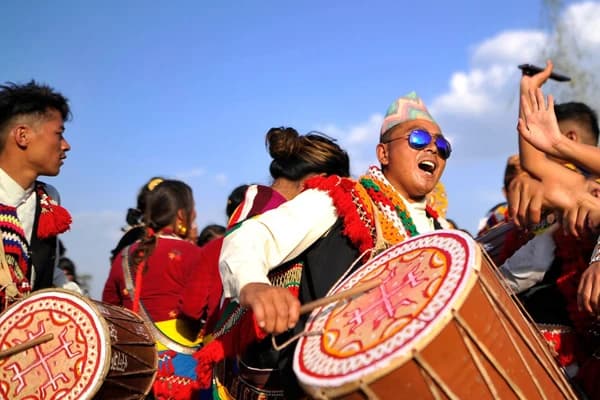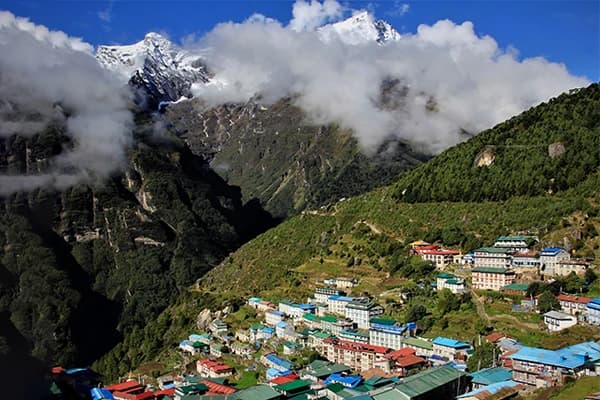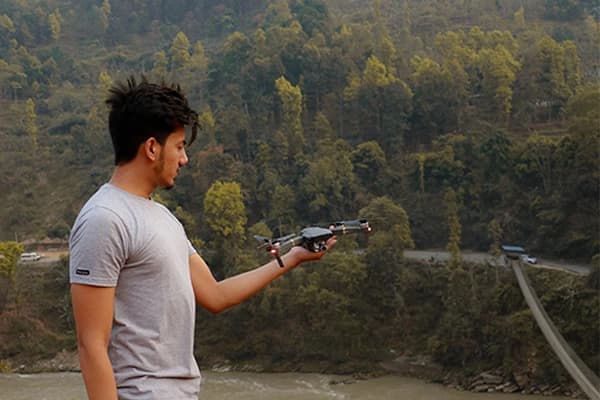Location and Accessibility
The south base camp of Mount Everest in Nepal is located in the northern part of Solukhumbu District within Sagarmatha National Park (a unesco world heritage site). The coordinates of the base camp are 28°0′26"N 86°51′34"E.
The base camp is accessible by a multi-day trek from Lukla, passing the popular villages like Namche Bazaar (3,440 m) and Gorak Shep (5,164 m). To reach Lukla, one has to take the flight from Kathmandu to Lukla airport.
There are several trekking routes that take you to the Everest base camp. Some of the popular trekking routes include the classic everest base camp trek, the gokyo lakes trek with ebc and everest base camp short trek, and so on.
High altitude risks and rest stops
The South Everest base camp is situated at the high altitude level of 5,364 meters (17,598 feet) above sea level. Therefore, it demands careful acclimatization strategies, with rest stops playing a critical role in mitigating altitude sickness risks.
The trek to Everest base camp begins in Lukla with daily altitude gains averaging 366–488 meters (1,200–1,600 feet) after acclimatization begins. It is challenging, so the rest stops are strategically placed in the villages like Namche Bazaar and Dingboche.
Stunning Landscapes
The south Everest base camp offers stunning views of the snow-capped peaks like Mount Everest, Lhotse, Nuptse, and ama dablam along with the vistas of the Khumbu Icefall. For the better sunrise and sunset views, you can hike to the Kala Patthar viewpoint as well.
The route to the Everest base camp offers views of the Dudh Kosi River along with popular valleys surrounded by the towering peaks, like Imja and Khumbu Glacier.
Sherpa and Culture Highlights
The south base camp of Mount Everest offers rich cultural experiences. The area is deeply rooted in Sherpa traditions and cultures. The Sherpas are great followers of the Himalayan traditions like Buddhist practices, storytelling, and unique customs.
A long time ago, the Sherpa peoples migrated from eastern Tibet and settled at the southern base of Mount Everest in the Solukhumbu Region. They choose the place because the place is near the Dudh Koshi River, which is essential for survival and agricultural purposes.
During the journey to the Everest base camp, there are several places like namche bazaar, Khumjung, and Khunde where you can experience the rich Sherpa cultures and traditions. In addition, the unique traditions can also be observed and learned in places like Tengboche Monastery.
Quiet, Remote, and Spiritual
The South Everest base camp is situated in the serene environment, quiet and remote away from the bustling city life. The people are engaged in their daily activities and operate several teahouses for a living. People there follow Buddhist tradition, which teaches to deal with calmness and also the real meaning of life.
The quietness is also because of the remote setting of the base camp. The people who are there are either locals, trekkers, or mountaineers. The more ascents you do, the quieter you find. Most of the areas besides the marked trails and spiritual monasteries are often untouched and unexplored due to their remote nature.
The Everest base camp itself does not offer you the spiritual experience, but the journey to the Everest base camp does. During the journey, you will visit places like Tengboche Monastery and other monasteries and shrines that teach you important things, including spirituality and the way of living.
Sense of Achievement
Reaching the Everest base camp gives you the physical and emotional rewards. The journey to the Everest base camp is not an easy job. You will be traversing rugged terrain, acclimatizing to high altitudes, and overcoming challenges like cold temperatures and steep ascents.
Overcoming the challenges provides a deep sense of personal triumph. Standing at the base camp of the world’s highest mountain is beyond the normal things. It evokes awe and pride.
In addition, the celebration of the accomplishment with fellow trekkers creates lifelong bonds. Those shared moments through laughter and storytelling enhance the sense of community and mutual respect.
Camping at Everest Base Camp
In high-altitude area like Everest Base Camp, there are no permanent tea houses or lodges. So, you have to either book a temporary teahouse or tented camps. The camping at the Everest base camp offers a unique adventure combining the breathtaking views, cultural immersion, and physical endurance.
In this adventure, you alone or with your group will have to manage everything from the camping materials to the cooking foods. This is one of the unique ways to connect with nature. Imagine gazing at the stars at night and enjoying every moment with your partner; how satisfying it is!
Or, you can book the tented camp managed by the local sherpas from the nearby areas. The amenities are limited and shared with communal dining areas, enough for those who are planning to climb mount everest or hike to the Kala Patthar.
In addition, it is also beneficial when you are trekking during the peak trekking season and find difficulty in booking accommodations even in advance. In this situation, camping in EBC is a very good idea, especially when you need rest and recovery for the next day's trek or hike or even the summit of Mt. Everest.
Camping in the Everest base camp is very important to avoid altitude-related problems. You cannot trek to the Kala Patthar directly without staying at night in the Everest base camp. It is very risky.
Challenges and safety
The journey to the South Everest base camp comes with several challenges and safety concerns. The primary concern is altitude sickness. The oxygen level drops to 50% at EBC.
In this situation, there is a high chance that someone can develop Acute Mountain Sickness (AMS), High-Altitude Pulmonary Edema (HAPE), and High-Altitude Cerebral Edema (HACE). For prevention, stay hydrated, use medications, and follow climb high, sleep low.
In addition, the rocky paths, steep ascents/descents (e.g., Namche Bazaar climb), suspension bridges, and uneven ground add more challenges to the journey. The weather conditions are also unpredictable in the EBC. To mitigate these challenges, packing essential gear, and preparing well before the trek is most important.
Furthermore, for safety purposes, a certified guide and a porter are beneficial. They make your journey comfortable. Buy travel insurance that includes helicopter evacuation and medical coverage up to an altitude level of 6000 m and stay updated with the trekking updates and weather conditions.
Environmental Considerations and Ethical Trekking
The growing popularity of trekking and climbing Mount Everest has led to significant environmental challenges like waste accumulation, microplastic and chemical pollution, water pollution, deforestation and soil erosion, overcrowding, and so on.
To mitigate these issues, sustainable tourism is being practiced in the Everest region along with the infrastructure developments, waste management, and climate adaptation measures. These practices are fueled by the funds raised from the Khumbu Pasang Lhamu Rural Municipality Entrance Permit cards.
The permit is to regulate tourism in the Everest region along with providing support to local infrastructure development and cultural heritage preservation.
Ethical trekking practices like using less crowded trails, such as the Gokyo Lake and Cho La Pass route or the Three Passes trek, carrying your own waste, and so on are practiced by the several trekking agencies.
Ready to go off-grid under Everest? Contact us to book your South EBC experience.





